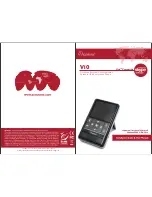
ACCESS Product Manual
41
If you’ve chosen an IP-based channel (such as
BRIC Normal
) then you’ll
be presented with two categories of options:
Local
and
Remote
. You’ll
use the
Local
Settings
to determine how your ACCESS behaves, and
the
Remote
Settings
will determine how the ACCESS on the far end
behaves. Each category lists identical options, so we’ll cover only the
Local
Settings
:
Connection Timeout
– Under normal circumstances, a connection will
be terminated on one end and the other end will drop the connection in
turn. But if a network failure occurs or a connection is ended abruptly (e.g.
killing power to an ACCESS), the system will drop the connection after a
pre-determined time. The default is 60 seconds, but this can be shortened
or lengthened here. If an indefinite connection is required, see
S
ectIon
8
o
PerAtIng
AcceSS
In
A
24/7
e
nvIronMent
for additional information.
Encoder
– It’s not necessary to define any decoder types when using
ACCESS because they automatically adapt to the incoming stream. Using
this menu, you can select the encoder used to send audio from this
ACCESS (local) as well as the encoder used to send audio to this ACCESS
(remote). The default value of the remote encoder is to follow the local
encoder i.e. it will send exactly the same codec mode it receives. This is
defined as
Follow Mode
in the remote encoder selection table. See
A
bout
the
A
lgorIthMS
section for more info on selecting encoders.
Transmit On/Off
– This option determines whether the selected encoder
(local or remote) is actually sending any data. By default, all encoders are
turned on, but there may be circumstances where one-way operation is
desired (e.g. multi-streaming, as described in Section 12). Turning off the
local encoder disables outgoing audio streaming, and disabling the remote
encoder disables incoming audio streaming.
Two options are available to help transmissions that are suffering from
poor network performance. There are encoder treatment options, so the
are applied to the “local” encoder, the “remote” encoder, or both. BRUTE
options require 2.7 or higher software on both ends of the link.
Congestion Avoidance
– Enabling this option allows the encoder to
dynamically change the number of frames/packet sent, thereby reducing
total data requirements. In addition, in most encode modes, enabling
congestion avoidance provides the system a license to step down to a
lower encode data rate if desired. This will happen automatically and with
no audio interruption. Step down congestion avoidance is not enabled in
ULB
,
HQ2
, or
Linear PCM
modes.
l
ocAl
& r
eMote
S
ettIngS
brute r
elIAbIlIty
o
PtIonS















































